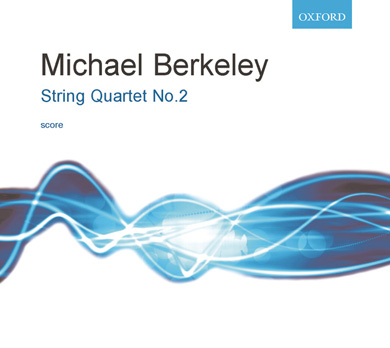Accompanied song
Ballet
Brass ensemble
Brass quintet
Chamber orchestra
Choral
Choral with orchestra
Concerto
Ensemble with string orchestra
Exhibition
Guitar
Instrumental
Instrumental ensemble
Opera
Quintet
Solo instrumental
String orchestra
String quartet
String trio
Vocal with chamber orchestra
Wind band
Wind quintet
String quartet works
Magnetic Field
Duration: 20 minutes
Year of composition: 1995
Published by Oxford University Press
Audio samples:
- Magnetic Field
The starting point for Magnetic Field was the string music of Purcell and in particular the Fantasia upon One Note. Here Purcell ingeniously finds the most exotic harmony imaginable with the repeated note always a natural or deliberately dissonant part of it.
This gave me the idea of seeing how, using contemporary techniques, I could use a single note – in this case F – as a kind of magnetic force around which everything else revolves. So the piece begins with the players attempting to move away from the F. At first this is in barely discernable quarter tones, rather like the plant's early effort to open its leaves and spread out from a central system which we can only fully appreciate through the medium of speeded up film. This leads into a sequence of frozen, widely spread chords, derived from the Lament in Purcell's Dido & Aeneas.
As the music becomes faster and more agitated, so the F casts its spell by its very absence. Only on its return does the music slim down and we are briefly back, for the close, in the tentative world of the opening.
The work was commissioned by the Vanbrugh Quartet with funds provided by the Arts Council of England, and was given its first performance by the Vanbrugh Quartet at the Wigmore Hall on 11 October 1995.
Quartet Study
Duration: 7 minutes
Year of composition: 1987
The eight-minute Quartet Study was composed in 1987 and was commissioned by what was then the City of Portsmouth International String Quartet Competition as the test piece for the 1988 competition. It was played by a lot of young upcoming quartets and it was fascinating to see how each imbued the music with the feel of their inherited traditions, the French quartets playing with Debussy-like elegance. The Hungarians came into their own because in fact it is very much influenced by the innovative string writing of Bela Bartok. It is abstract expressionist in character, contrasting driving and pulsating rhythms with vulnerable, tender music. It served as a test piece for me too since it led to Magnetic Field for the Vanbrugh Quartet and Torque and Velocity for the Takas. When some years later the Artditti String Quartet applied their specialist ‘contemporary’ experience to the music it came over with the ferocity of a machine gun.
String Quartet No. 1
Published by Oxford University Press
The String Quartet No. 1 was used by Michael Pink for his 1982 ballet 'Attractions' for Northern Ballet. The Amphion String Quartet gave the first performance at the premiere of the ballet.
String Quartet No. 2
Duration: 18 minutes
My second string quartet was written during the autumn of 1983, and is in one movement lasting a little over a quarter of an hour. It begins with a cello solo which, with the intervals created by the entries of viola and violins, form the basis of what is to follow.
I found myself at something of a musical crossroads before and during the composition of the quartet, but in the course of writing it, a new direction began to emerge. This utilises a freer, more random use of thematic material, and indeed, the final bars of the quartet dispense with barlines altogether, though the sound is always very carefully controlled. This last passage contrasts sharply with the central section of the work, which is tight and rhythmic. The quartet consists, therefore, of three interrelated and continuous sections.
The quartet was commissioned by the Merlin Music Society with assistance from the Welsh Arts Council. It was first performed by the Gabrieli String Quartet at a Merlin Music Society concert in Monmouth, on 15 January 1984.
Torque and Velocity
Duration: 15 minutes
Published by Oxford University Press
Torque and Velocity is Michael Berkeley's fifth composition for string quartet. It was commissioned by the Cheltenham Music Society (with financial assistance from South West Arts) for the Takács Quartet, which gave it its first performance at the Pittville Pump Room in Cheltenham on 15 October 1997. Berkeley says that it was the Quartets special qualities of exhilarating vigour coupled to innate musicianship, as exemplified in their playing of the Bartók quartets, which helped dictate the nature of the piece.
Like Berkeley's previous string quartet, Magnetic Field of 1995, this work is in a single movement; and again it has a title derived from physics - torque being the rotary movement produced within an engine. The composer likens the opening gesture to the flicking of a switch which sets the piece in motion. It then accelerates through the gears, as it were, gradually building up increasing momentum with each change of tempo and texture. The energy thus generated throws off sparks in the form of vocal interjections; and at the climax precise pitches and rhythms are briefly abandoned in passages of freely co-ordinated manic, sawing glissandi. However, the works obsessive forward movement is interrupted from time to time by moments of stasis, with quiet, widely spaced chords and expressive fragments of melody. And one such quiet moment occurs at the end of the piece, before the final click of the switch.


